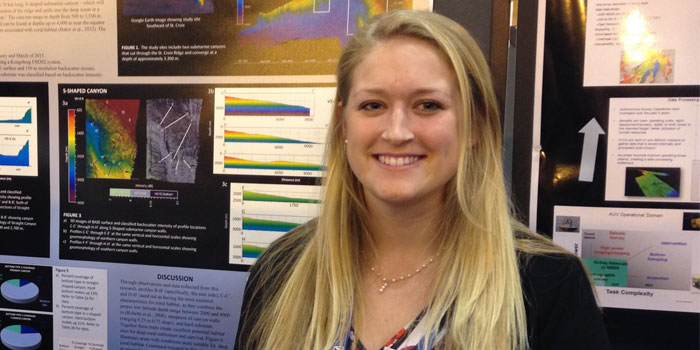
Meet Julia Gorton
Julia Gorton is an Explorer-in-Training who worked at the College of Charleston Geology Department’s Visualizations Lab in Charleston, South Carolina, analyzing the ocean floor using data collected from NOAA Ship Okeanos Explorer. Read the full text of Julia’s interview below to learn more about her experience.
About Julia's Role
Where were your duties as an Explorer-in-Training?
My duties consisted of selecting an area of the seafloor to study from data sets available on NOAA’s Bathymetric Data Viewer. The Data Viewer is a map of the seafloor displaying multibeam data collected by ships. This data is available to the public to download and use. I imported the data into a comprehensive hydrographic and sonar data processing system and then created and interpreted the map of that data set. The data I used was collected by NOAA Ship Okeanos Explorer.
Which school are you attending?
I graduated from College of Charleston in May 2015.
Where was your work experience located? If you were working at sea, what were your impressions of living and working on a ship?
I worked primarily in the Geology Department’s Visualizations Lab at the College of Charleston in Charleston, South Carolina. Since I downloaded the data off of NOAA’s Bathymetric Data Viewer, I did not actually work at sea, but was able to conduct my research directly from the computers in the Visualizations Lab at school.
What sparked your initial interest in ocean sciences?
Growing up on Long Island Sound, I have always been interested and fascinated by the ocean. In high school, I took all of my science courses at the Bridgeport Regional Aquaculture Science and Technology Education Center (BRASTEC), including biology, chemistry, Culture of Aquatic Species (where I raised and cultured tilapia), and ecology. During the school day, I went out on BRASTEC’s boat, the R/V Catherine Moore, where we used oceanographic instruments and a remotely operated vehicle and trawled Long Island Sound to identify and learn about local fish and invertebrate species. By the end of my freshman year in high school, I knew I wanted to study marine biology.
What was the most personally rewarding part of your experience?
The most rewarding part of my experience was having the opportunity to present my research at the Ocean Sciences Meeting in New Orleans in 2016. It was great to be able to share my research with a varied audience of students, professors, and marine science professionals. I loved the enthusiasm everyone showed regarding the poster I presented!
What is the most unexpected thing you have learned?
I think what surprised me the most is how much I could do with the information collected by NOAA Ship Okeanos Explorer and all the information we can get from maps of the ocean floor. Seeing that so much is unknown about the ocean and so little of the ocean is mapped, I'm excited to learn about future discoveries and new ways that we can apply collected data.
Please describe your final project.
I downloaded raw data from NOAA’s Bathymetric Data Viewer, and I chose to look at the bathymetry and backscatter of the seafloor to the southeast of St. Croix using data collected from NOAA Ship Okeanos Explorer in early 2015. Backscatter is the amount of acoustic energy being received by the sonar after a complex interaction with the seafloor. This information can be used to determine bottom type, because different bottom types “scatter” sound energy differently. The higher the energy, the harder the seafloor or object the beam encountered. After creating a bathymetric surface map and seeing what the seafloor actually looked like, I started to ask questions about what kind of habitat that area might contain. I decided to look into finding areas with the highest potential for deep coral habitat. By calculating the slope of canyon walls and percent coverage of hardground, which I estimated using backscatter, I was able to find the combination of steep canyon walls and hard bottom that are suitable for deep coral settlement and growth. I presented my research at the Ocean Sciences Meeting 2016 in New Orleans.
How do you see this experience fitting in with your future career plans?
In the future, I hope to be able to actually go offshore and collect my own data before interpreting it. I would like to work on habitat mapping and potentially help set up marine protected areas for fragile, useful, ecosystems.